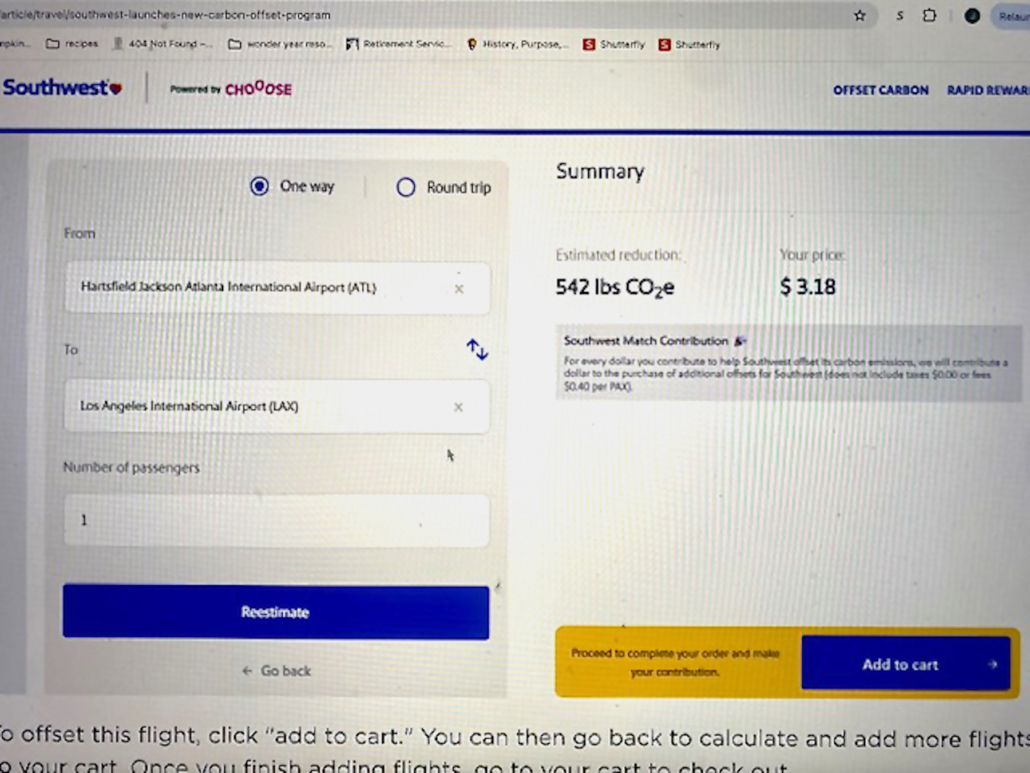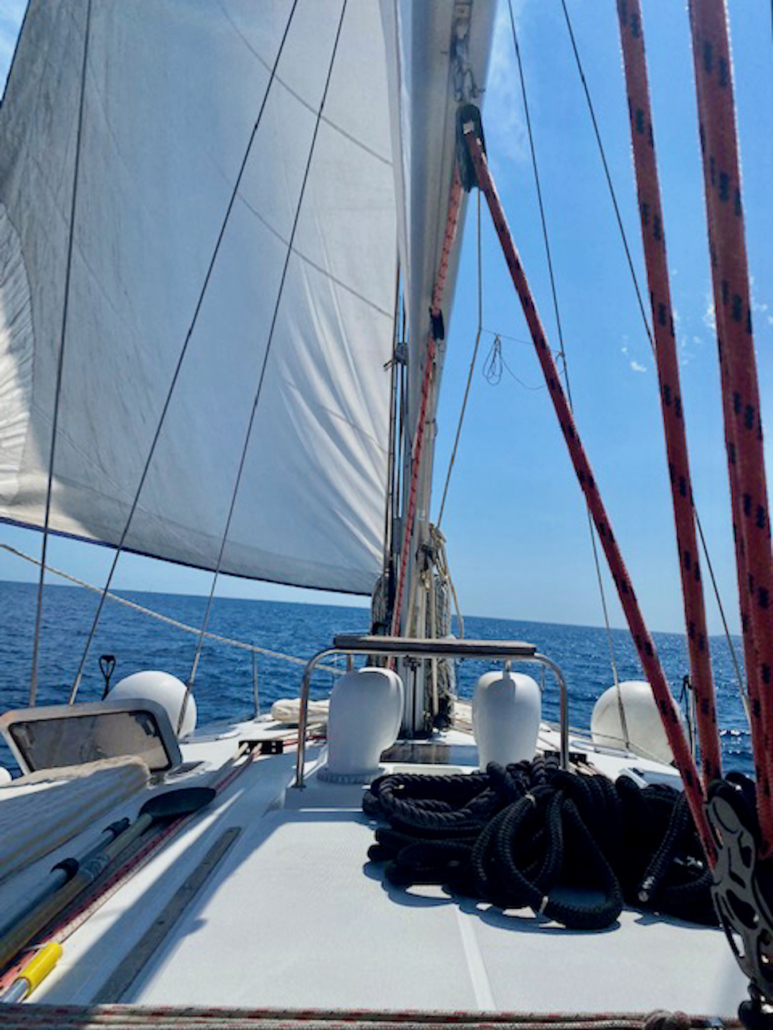Carbon Offsets
Climate change is one of the most consequential environmental issues of our day. Its devastating effects – drought, extreme rainfall, wildfires, sea level rise, forced displacement of people, loss of cultural identity, and many others – will keep getting worse until we find a way to stop putting so many heat-trapping greenhouse gases into the environment. The good news is there are climate solutions everywhere. This blog takes a close look at one mechanism in the massive portfolio of potential climate solutions – carbon offsets.
If you have been on a commercial flight in the past few years, chances are you have come face to face with a carbon offset offer from the airline. It may have been a click enabling you to “fly green” or a calculator to help determine the carbon footprint of your trip.
What are Carbon Offsets?
A carbon offset is a mechanism to “cancel out” the amount of carbon associated with one activity by reducing emissions in another activity or a different location. The basis for the offsetting model is that greenhouse gases mix globally in the atmosphere, therefore it does not matter where we reduce carbon emissions. It’s just important that we reduce them.
We should also recognize that the most vulnerable communities bear the worst of climate change impacts while contributing the least to the problem. Carbon offsets offer one way to help these communities by supporting sustainable development and alleviating poverty.
For worldschooling families, understanding carbon offsets can help us travel sustainably and responsibly. The topic also provides a timely and fascinating worldschooling lesson in science, economics, geography, chemistry, entrepreneurship, and sustainability. Let’s look at how the carbon offset market began.
History of Carbon Offsets
In 1997, the United Nations hosted a meeting of countries where they adopted the first international climate agreement, the Kyoto Protocol. It mandated that some countries reduce their carbon emissions. Those countries in turn argued they could do a better job of reducing carbon emissions (it would cost less and they could do more) if they could “offset” their carbon emissions from anywhere on the planet. So, for example, a European signatory to the Kyoto Protocol could invest in planting forests in South America. The “carbon credits” that accrue from that reforestation project could be used to meet the carbon reduction obligations of that European country.
Today, it’s not just countries undertaking offset activities. Companies, nonprofit organizations, investment houses, and travelers can make voluntary commitments to offset their carbon impact, helping to achieve broader sustainability goals. The popularity of voluntary carbon offsets has created an enormous market, which some industry analysts predict will reach $250 billion by 2050.
Carbon Offsets in the Tourism Industry
The travel and tourism industry is responsible for about 10% of global carbon emissions. Every time we head out on a trip, drive to the airport, take a flight, sleep in a lodge, or use single use plastics, we generate carbon emissions. The airline industry is “on board,” so to speak, and is looking for ways to lessen its aviation carbon footprint through things like sustainable aviation fuels, route optimization, and more efficient aircraft. As travelers, we can get “on board” by flying less, walking or biking instead of driving, staying in hotels with solar panels, taking an overnight train instead of a regional flight, skipping the plastic straw, and recycling more. But, no matter how good of a job we do, no matter how good of a job the aviation industry does, there will always be more carbon to cut. That’s why carbon offsets are so important.
Types of Carbon Offsets
There is a wide variety of carbon offset projects and platforms around the world. These projects enable individuals and organizations to balance their carbon impacts in a variety of ways. Some are nature-based projects that aim to enhance biodiversity, improve forest management, restore coastal ecosystems, and promote renewable fuels (such as solar and wind). Others are technology-based solutions that focus on improving manufacturing processes and cutting pollution at the source.
Below is a sample of carbon offset projects that illustrate the breadth of options available today:
Cool Effect is a nonprofit that supports a range of carbon-reducing projects. On the Cool Effect platform, organizations and individuals can calculate the impact of a planned event, activity, or business function, then purchase offsets through one of the vetted projects to achieve net zero emissions.
One Tribe helps businesses fund rainforest projects by working directly with Indigenous landowners and forest conservation partners. The Great Bear Forest Project, Canada’s first Indigenous-led forest management project, is a fine example of One Tribe’s work. One Tribe also has an e-commerce plugin that helps businesses and consumers generate forest protection microdonations with every purchase.
8 Billion Trees offers a selection of carbon offset projects that support the Amazon Rainforest and wildlife conservation. Concerned about ecosystem health and not just planting trees, 8 Billion Trees makes sure that the trees planted are endemic to the area.
Climate Vault – Climate Vault buys up permits that would allow carbon pollution, effectively “locking” those permits away and keeping tons of CO2 out of the atmosphere.
United Nations Carbon Offset Platform – The United Nations Carbon Offset Platform is a one-stop shop to support those interested in offsetting their carbon impact. On the UN Platform you can first estimate household emissions and then select a project that balances out that impact. Some of the current projects are:
Solar Power in Korea that is replacing coal-fired power plants
Wind Power in Jamaica that is reducing fossil fuel use and preserving natural resources
Biogas Project in Cambodia that is recovering and utilizing methane, a greenhouse gas that is 28 times more potent than Carbon dioxide
All of the projects available through the UN Platform are Clean Development Mechanism (CDM) projects. That means they are authorized by designated authorities and have a high level of accountability.
The above examples represent a small fraction of the offset projects currently available. There is tremendous growth in the number and variety of programs on the market and we expect the continued proliferation as more companies and countries commit to climate action.
The Problems with Carbon Offsets
While offsets can do good in the world by sequestering carbon, funding reforestation, enhancing conservation, and supporting local community sustainability, there are some serious problems to be aware of:
- Flight Carbon Calculators generate only an estimation – There are several tools to estimate the carbon impact of your flight and it’s super cool to plug in your data and see how much carbon will be emitted. But it’s not that straightforward. Nothing about carbon offsets is simple! Many factors can affect the emissions of a flight including type of aircraft, class of seating (first class is the worst since it takes up more space per person), how full the flight is, how the plane was fueled up, the weather conditions on the day of travel, etc.
- True cost– It’s often the case that for longer flights, the cost of an offset is insufficient to cancel out the true carbon impact. This New York Times Wirecutter article takes a deep dive into the question about whether buying that $20 offset actually cancels out the true environmental impact of a 5000 or 10,000-mile flight.
- Fraud and “Phantom Offsets” – In January 2023, the Guardian published a scathing report that exposed the failure of many rainforest offset projects, arguing that 90% of the offsets by the biggest certifier at the time were not actually leading to carbon reduction. It was a shocking and important revelation, as many large and reputable corporations were involved. The problem is basically a methodological one – it’s very difficult to know with confidence how much carbon one hectare of forest can sequester and how much impact can be credibly claimed.
- Quality assurance – There is no single standardizing or verifying body to check the veracity of all offset claims. However, there are many independent third-party organizations conducting rigorous analysis today. It’s critical that before purchasing an offset you look for proper accreditation and verification through such entities as American Carbon Registry, Gold Standard Impact Registry, and Verra.
- Greenwashing – Offsets alone will not solve the climate crisis. They must work in tandem with absolute emissions reductions. Some companies try to win over customers by saying they are green. They tout their offset programs while making no actual changes to their practices or business operations. According to United Airlines CEO, Scott Kirby, “The problem with offsets is that it’s basically saying you are going to plant trees, or saying you are not going to cut down trees. Nothing wrong with saving trees. But the reality is the vast majority of those projects are fraud. They are forests that were never going to be cut down or were forests that were going to be planted anyway. Even for legitimate projects, it’s not scalable. The problem is, everyone is using carbon offsets as the easy way to check the box. It’s too easy to say, ‘I’ve done my part for net zero.’” Scott Kriby is basically saying, “We can’t buy our way out of this problem.”
The problems above may seem daunting but we mustn’t let them deter action. Instead, we can ask the hard questions, examine our choices, take the chance to learn together as a family, and be intentional. And as we weigh the tradeoffs that come with family travel, we can skip the guilt and instead welcome the opportunity for discovery, wonder, learning and making a positive impact. Carbon offsets are an important tool in our toolbox and they give us an opportunity to lighten our footprint on our one, our only, our beautiful home, Planet Earth.
To learn more about about carbon offsets and sustainable long-term travel, check out this carbon offset guide and our Wonder Year 2023 Earth Month post which dives a little deeper into the topic of sustainable travel.









Trackbacks & Pingbacks
[…] has free resources and blogs on relevant and current topics like AI and Worldschooling, carbon offsets or even the family travel angles for various destinations. Our blog also highlights worldchooling […]
Comments are closed.